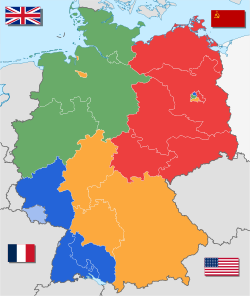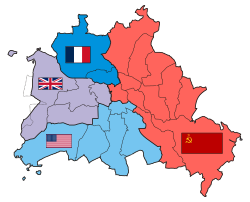British occupation zone in Germany
The Allied powers who defeated Nazi Germany in World War II divided the country into four occupation zones from 1945 to 1949.
German Reich Deutsches Reich | |||||||||||||||
|---|---|---|---|---|---|---|---|---|---|---|---|---|---|---|---|
| 1945–1949 | |||||||||||||||
 Post-Nazi German occupation borders and territories from 1945 to 1949. British (green), French (blue), American (orange) and Soviet (red) occupation zones. Saar Protectorate (light blue) in the west under the control of France. Berlin is the quadripartite area shown within the red Soviet zone. Bremen consists of the two orange American exclaves in the British sector. | |||||||||||||||
| Status | Military occupation | ||||||||||||||
| Capital |
| ||||||||||||||
| Governors (1945) | |||||||||||||||
• British zone | F. Mar. Montgomery | ||||||||||||||
• French zone | Gen. Lattre de Tassigny | ||||||||||||||
• US zone | Gen. Eisenhower | ||||||||||||||
| Marshal G. K. Zhukov | |||||||||||||||
| Historical era | Cold War | ||||||||||||||
| 8 May 1945 | |||||||||||||||
| 5 July 1945 | |||||||||||||||
| 15 December 1947 | |||||||||||||||
| 23 May 1949 | |||||||||||||||
| 7 October 1949 | |||||||||||||||
| 12 September 1990 | |||||||||||||||
| Population | |||||||||||||||
• 1945 | 64,260,000 | ||||||||||||||
• 1949 | 68,080,000 | ||||||||||||||
| Currency |
| ||||||||||||||
| ISO 3166 code | DE | ||||||||||||||
| |||||||||||||||
| Today part of | |||||||||||||||
| |||||||||||||||
 The four sectors of the Allied occupation of Berlin and exclaves. | |||||||||||||||
The British zone consisted of Schleswig-Holstein, Hamburg, Lower Saxony and the present-day state of North Rhine-Westphalia. The British military government was based in Bad Oeynhausen.
Bremen and Bremerhaven were surrounded by the British Zone, but were given to the United States, so that the Americans had a port. What is now Rhineland-Palatinate was to be a part of the British Zone. It was given up to form part of the French occupation zone.
In May 1949 the British, French, and American zones were joined to form the Federal Republic of Germany. The military governors were replaced by civilian high commissioners. The high commissioners were part-governor and part-ambassador. The occupation officially continued until 1955. This is when the Federal Republic became a fully sovereign state, the western occupation zones ceased to exist, and the high commissioners were replaced by normal ambassadors. But the four allied powers still had special rights and responsibilities in Germany until the Final Settlement of 1990.
The city of Berlin, however, was not part of either state and continued to be under Allied occupation until 1990.
The military governors and commissioners
changeMilitary governors
change- 22 May 1945 - 30 April 1946 Sir Bernard Law Montgomery, 1st Viscount Montgomery of Alamein
- 1 May 1946 - 31 October 1947 William Sholto Douglas
- 1 November 1947 - 21 September 1949 Gen. Sir Brian Robertson, Bt.
High commissioners
change- 21 September 1949 - 24 June 1950 Gen. Sir Brian Robertson, Bt.
- 24 June 1950 - 29 September 1953 Sir Ivone Kirkpatrick
- 29 September 1953 - 5 May 1955 Sir Frederick Hoyer-Millar
Related pages
changeReferences
change

